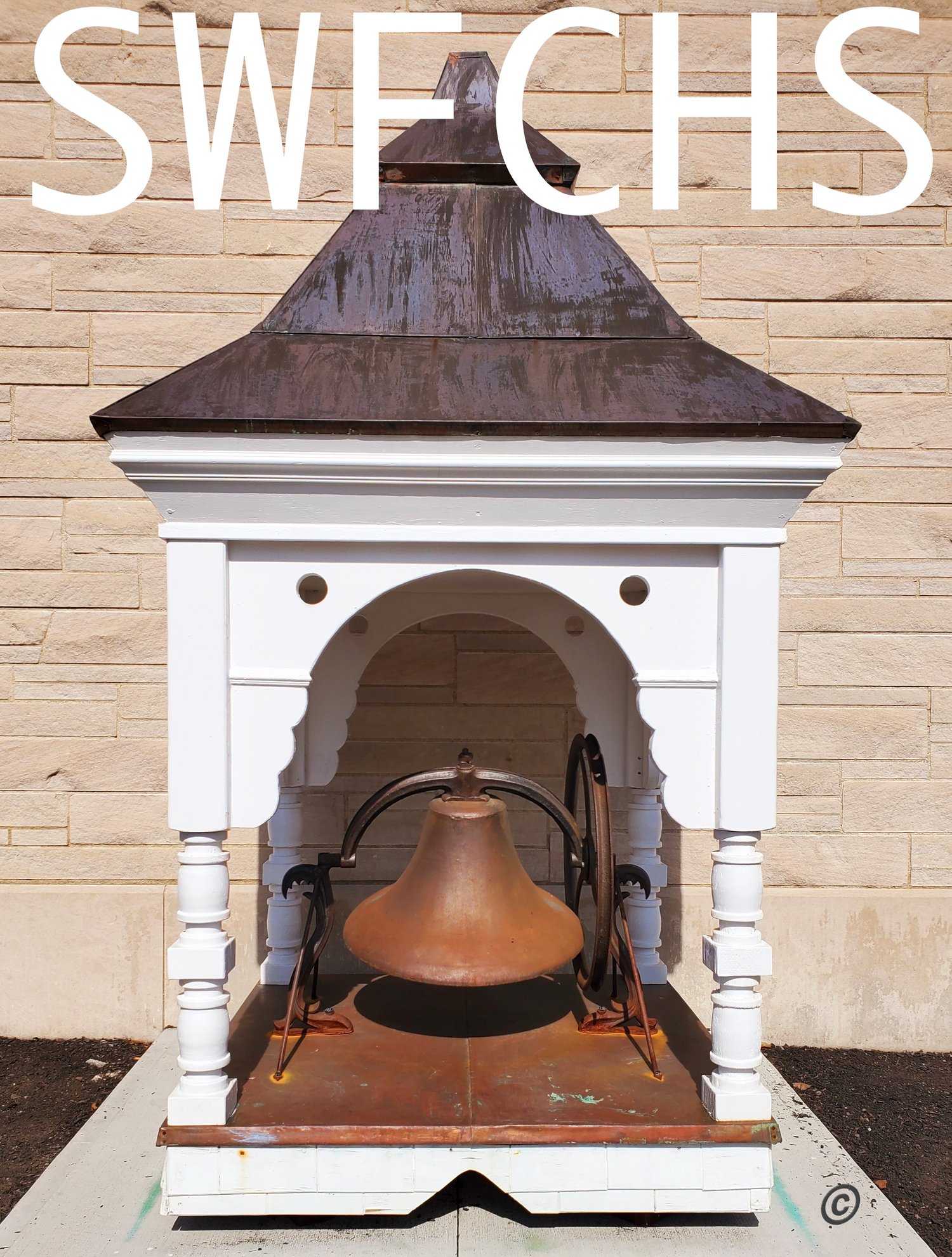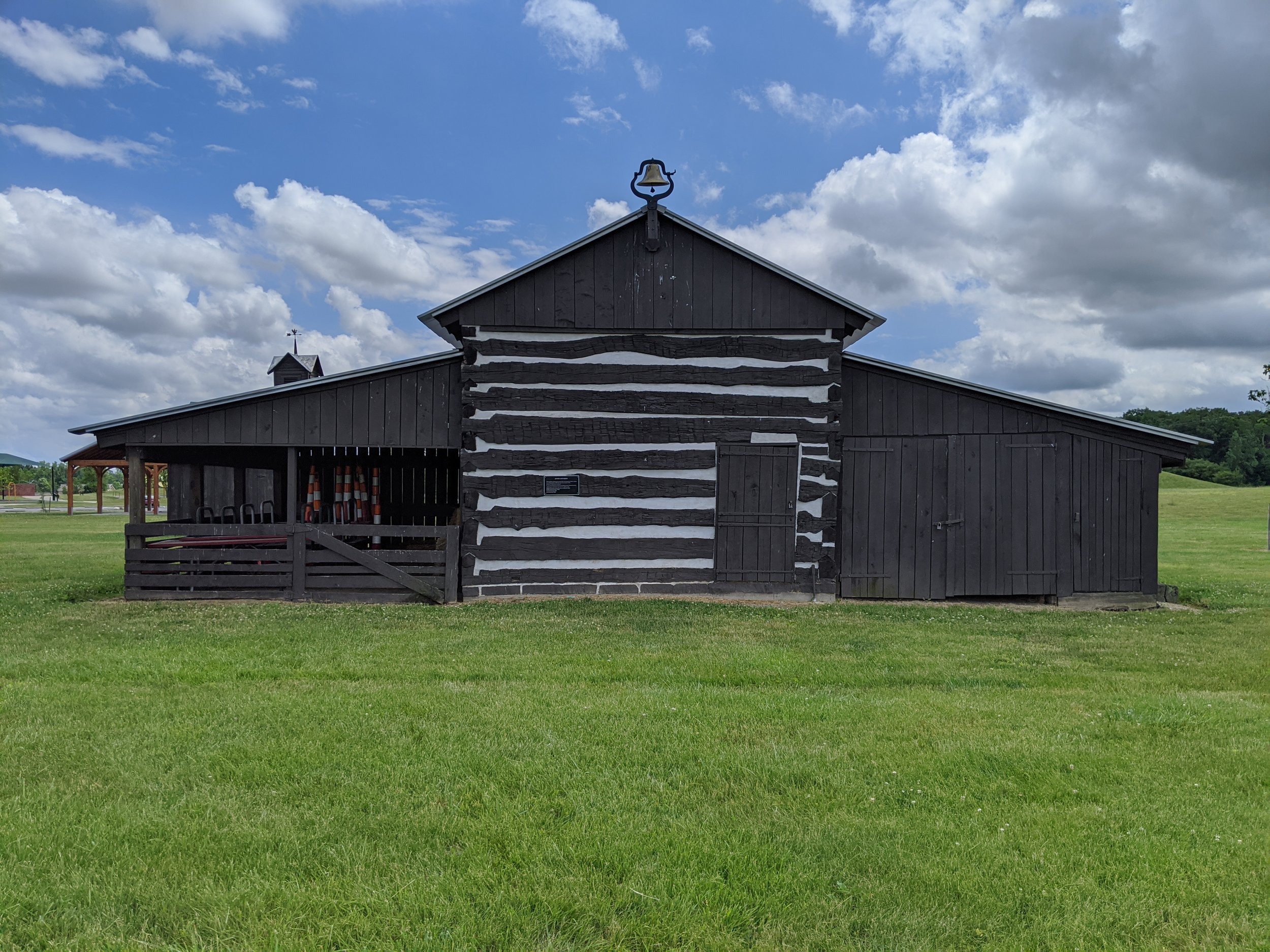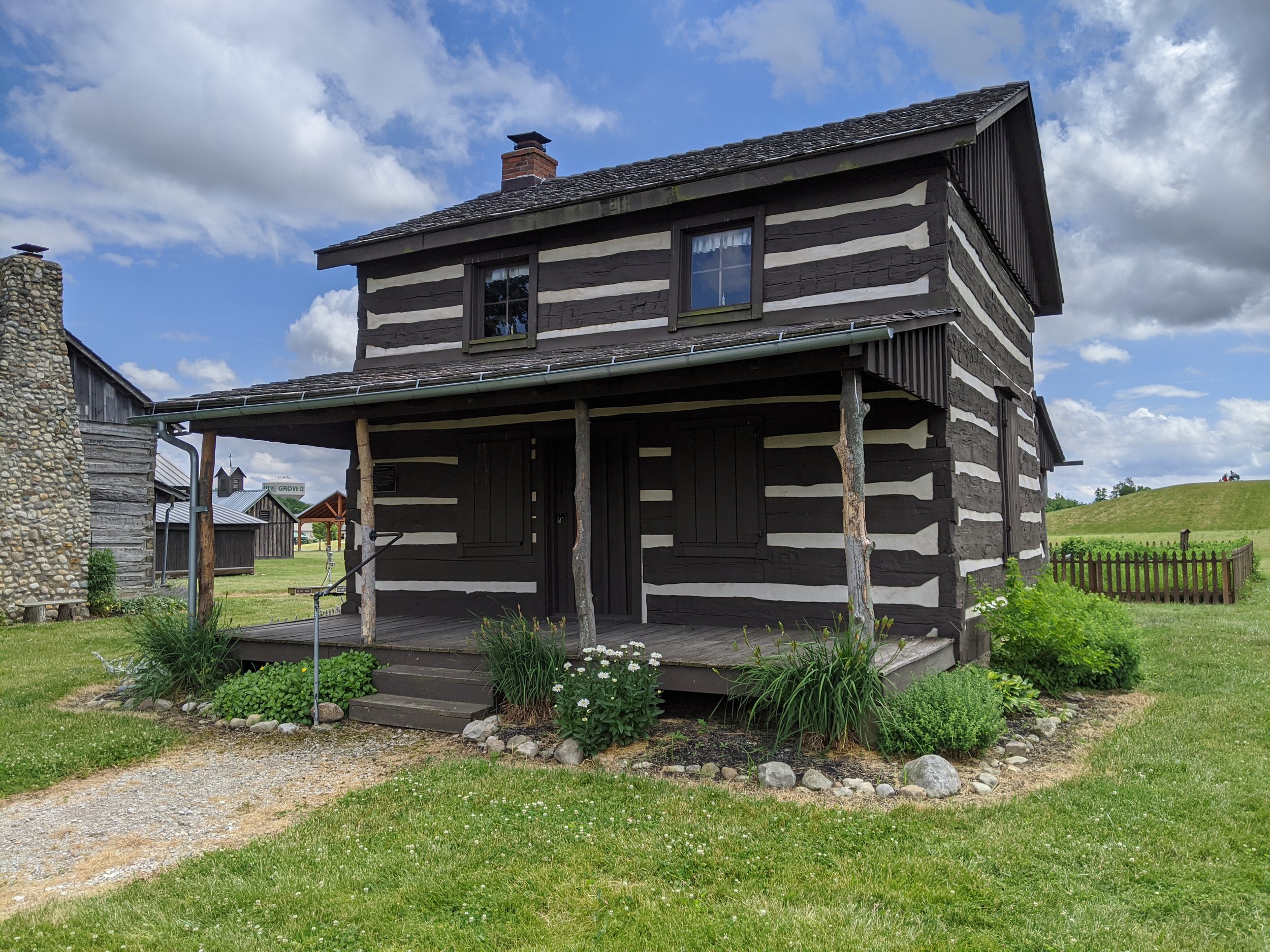
CENTURY VILLAGE
4185 Orders Road
Step back in time and experience life in the mid-1800s at Grove City’s Century Village Historic Park. The log structures and the farm museum with antique tools inside the Bob Evans barn will demonstrate the skills and hard life early settlers experienced.
Century Village Touring Options
Open Houses are held on the fourth Saturday from May through September from 2-4 p.m. (Note: the July 27th Open House has been cancelled due to scheduling conflicts). In addition, from May through October, guided tours of the Train Depot are held the first Wednesday of the month, and Schoolhouse tours the third Wednesday of the month, running from noon-4p. There is no admission and parking is free.
Group tours of Century Village can be scheduled at the Tour Requests page. There is a small charge involved. This is very popular with the local schools, but anyone can schedule a tour.
The village is also open for Heritage Celebration (second Saturday in June) and Old Time Harvest Day (first Sunday in October). Both of those events are free. Sit down and experience a one room school, rope making, children’s games, cabin life and much more during the festivals. Take time to ask questions and interact with volunteers who are dressed in period clothing.
Finally, you can visit the village and view the building exteriors without a reservation, daily from dawn to dusk.
Please note—the train depot is ADA compliant with a ramp to enter the building, while the Schoolhouse is NOT ADA compliant. Navigating a few stairs to enter the schoolhouse is necessary. No food or drinks are permitted in the buildings.
Development of Century Village
Did Gantz Farmhouse Spark an Interest in Historic Preservation?
Some residents might say the idea for local history and preservation efforts started as early as 1980 but the first discussion of preserving the Orders Road School dates to December 1995. The Grove City Historical Society was in existence then, but its single focus was preserving the history of the city’s original Park Street School, once located at Park Street and Arbutus Avenue.
The planned destruction of the Gantz farmhouse in 1980 to create a park was a spark that ignited interest and a movement toward historical preservation. Originally Mayor Cheryl Grossman asked city council to appropriate $100,000 for Gantz restoration but the request was met by opposition when one member of council said a new building could be built for that much money. Estimates were calculated and a $35,000 fundraising effort started to restore the 1840 era farmhouse. Eventual restoration was $31,000. Karen Gunderman was a member of that original group which pressured city officials to preserve the structure and not tear the house down. She also spearheaded the fund-raising effort which was fruitful. Barry Babbert, director of Grove City Parks and Recreation, took the lead on behalf of the city.
After the project was completed, a group working with the Grove City Area Chamber of Commerce held an annual event there beginning in 1983 known as Maifest Also called Springfest for a period of time, Grove City also made references to the event as Pioneer Week. Maifest was the first time Civil War re-enactors camped and drilled in Grove City.
Gantz Park and its herb gardens was Grove City’s centerpiece part of the international garden show, AmeriFlora’92. That event was held at Franklin Park in Columbus. Gantz had a record attendance that year.
Eight years after the planned destruction of the Gantz farmhouse, the city purchased a large tract of land on Orders Road for another much larger municipal park.
At the time, only one building faced Orders Road. It was an old brick schoolhouse that had shut down around 1928.
“The Northwest Ordinance of 1787 mandated public education for children. The school appears on township records 92 years later in 1879 when the land was gifted to the township by the Orders family. However, the building might be considerably older,” according to Steve Jackson.
“The brick mason working on the building told me he would bet that the structure dated to the 1850s or 60s, based on the brick work. That is possible as families often would provide a building; the township would provide the teacher. In 1879, Mr. and Mrs. Orders were at an age where they would probably not want that responsibility,” Jackson said.
As interest began to grow about the project, Mayor Cheryl Grossman and Ray “Pudge” Eesley had numerous meetings considering various options for the old school but restoration was always the goal.
As the school project moved forward, a volunteer group organized. Members included Eesley, Marilyn and Max Gibboney, Steve Jackson, Don Kientz and Louie and Joan Eyerman. As interest in the project increased, others joined the effort.
Joan spoke by phone with Southwest Franklin County Historical Society President Marilyn Gibboney and the they decided the two groups should meet and consider joining forces. An agreement was made and a School House Subcommittee of the historical society was formed.
The old structure had a major structural problem. A large portion of the building had been removed to allow farm equipment to be parked inside. The first task of restoration was to repair that hole with matching brick; easier said than done. A large collection of bricks on skids was uncovered at a Columbus business on Harmon Avenue but the owner wasn’t interested in selling his brick.
At one point, Eessley and others almost gave up on the project because matching bricks couldn’t be found.
The old Walnut Grove School building where Joan Eyerman’s father, Alva Taylor, attended was on property belonging to her sister, Marilyn Wright. The school was torn down and volunteers cleaned more than 13,000 of those bricks so the restoration project could begin. Bricks not needed were sold.
One day when volunteers were working at the school, a motorist stopped and questioned what was happening. The area then was referred to as Historical Park. The motorist told the volunteers they needed a sign so people driving by would have an idea of the project. As a result of that motorist, the name Century Village was suggested, adopted and a sign erected. The person who suggested the name isn’t known.
The school project was just the first phase of what would become a massive undertaking.
In 1997, a log house, built around 1840, was donated to the historical society by Don Kientz. It had been the home of William Kegg on Beatty Road as early as 1860. In 1915, the land and house were purchased from the Kegg family by the Ruoff family. In 1960, it was sold to the Kientz family.
The structure was made from logs cut from the forest that once covered Jackson Township. In 1998, the house was dismantled under the supervision of Carl Green. Logs were stored in a barn on the property of Don and Juanita Kientz for nearly six years. Carl had marked each log with a slip of paper showing how to reconstruct the structure. Unfortunately, when it came time to reassemble, the identifying slips of paper were missing; they had been eaten by mice.
With the instructions missing, the logs for the cabin were moved to the Grove City Lumber Yard. While there, photographs of the building were used by Mike Boso, Louis Eyerman and Carl Green to reassemble the cabin inside the barn. The timbers were remarked before being moved to Century Village. Before leaving the lumber yard, the logs were also treated for insects.
The endeavor became a community project. Grove City Boy Scout Troops 392, 385, 623 and 275, coordinated by Ben Brace, helped move logs, saw away damaged or rotten wood and other tasks. A total of 64 boys and men camped one weekend at Century Village in 2002 helping raise the cabin.
Students from the Paul C. Hayes Vocational School also worked on the project. They built the furniture in the building to the same style and design as it would have been in the mid-1800s. A decision was also made to restore the interior to its original look and that task of plastering the four walls was left to Jim Martin.
The reassembly was completed in 2003 and a public open house was held in May.
With a new historic park came the need for a new event. The Eyerman’s, in 2000, created an event first identified as The Annual Historic Time Line Re-Enactment. This included re-enactors from the Civil War era and other re-enactment groups, such as His Majesty’s 4th Regiment of Foot Loyalists who fought against George Washington during the American Revolution.
Dr. David McMahon, a real-life surgeon and a Civil War surgical re-enactor, was one of the first to register. McMahon was familiar with Grove City; he had also demonstrated his Civil War medical collection in 2000 at one of the first Maifest events at Gantz Park. This event at Century Village provided an important place for reenactment groups to meet, camp, recruit and drill. Regular cannon fire was also popular at many of the events but disturbing to some nearby neighbors.
At the suggestion of James Hale, the event’s name was shortened to The Encampment making it much easier to promote in advertising. Hale helped promote the historical events through the Grove City Area Visitors and Convention Bureau.
Today, the event has been renamed again and is known as the Heritage Celebration at Century Village. The Southwest Franklin County Historical Society sponsors another public event in the fall known as Old Time Harvest Day which became a regularly scheduled event a year after the Kegg-Kientz log house dedication.
“I had a few historical skills for people to watch at the dedication,” according to Joan Eyerman. “Everyone enjoyed it so the historical society decided to do it again and it became an annual event.”
Orders Road School
Educational standards for rural children did not exist during the early 1800s, but by the 1870s Ohio had enacted compulsory education laws. In rural areas, township school districts opened schools, like the one at Century Village. Local citizens were assessed a fee for upkeep and teacher salaries.
In 1879, Allen and Mary Orders deeded one acre of land to the Jackson Township Board of Education. The Orders Road School was identified as #10. The school may have already been located on that property. Three generations, ages five through 16, attended the school for their primary education.
Any student who completed the eighth grades could take the Boxwell Exam. A good score proved the student had knowledge equal to a high school education. It also allowed the student to attend college or become a teacher. The Boxwell Exam was important in the late 19th Century when not all communities had high schools.
Teachers in Ohio were required to pass a county examination to receive a teaching certificate. Besides instructional duties, teacher kept all school records, cleaned the schoolhouse and kept the building heated during the cold months.
Kegg-Kientz Log House
This log home was built on property purchased between 1860 and 1880 by William Kegg, a prosperous land owner in Franklin and Pickaway County. In 1915, the land and house were purchase from the Keggs by the Ruoffs. In 1960, the land was sold to the Kientz Family, who donated the house to Southwest Franklin County Historical Society and the City of Grove City in 1997. The house was dismantled with the help of inmates from the Orient Correctional Institution and placed in storage for 6 years, and rebuilt in a joint effort of the SWFCHS, the Boy Scouts and the City. The original location for this log cabin was Beatty (Kegg) Road. It was reconstructed in Century Village in 2003-2004.
Jones Log Barn
This log barn, constructed around 1850, was donated by Patty L. Jones. It was dismantled in 2005 with the help from inmates of the Pickaway Correctional Institution. It was reconstructed by the Southwest Franklin County Historical Society volunteers in conjunction with the City of Grove City. The original location was on the Jones property on Rensch Road. It was reconstructed at Century Village in 2006.
Train Depot
The Grove City railroad depot was built in 1884 by the Cincinnati Midland and Columbus Railroad Company. Passenger service ended in 1956 and in 1972 the railroad closed the freight station. The depot was relocated in 2018 by the City of Grove City from its original Front Street location in the Town Center.
Borror-Roach Windmill
Windmills harnessed wind power to pump water from wells freeing farmers to use time and labor on other tasks. This windmill is reconstructed with parts from two separate windmills, one from the Borror Farm (donated by M/I Homes) and another from a Demorest Road farm (donated by B.J. and Jody Roach), Both windmills were originally constructed around 1870 and moved to Century Village in 2008.
Bob Evans Double-Crib Log Barn
Crib barns were made of rough-hewn logs notched and laid horizontally; gaps went unfilled to save labor and provide ventilation. The multifunctional structures sheltered livestock, held feed, stored equipment, and more, such as housing a blacksmith shop. This barn, originally built in Perry County, was dismantled and stored before being purchased and reconstructed by the Bob Evans Farm at Rio Grand, Ohio. It was later donated to the Southwest Franklin County Historical Society and the City of Grove City. Replacement logs and other lumber were donated by Andy Deshong. Blacksmith Jim Brown, a SWFCHS member, hand forged replacement hinges and latches.
The barn was constructed ca. 1860-1890 and reconstructed at Century Village in 2010-2011.
Funk-Ziegenspeck Granary
Granaries were used to dry seeds for the family to use to sow crops the next growing season. This small granary was built on the Ziegenspeck Farm, located on Harrisburg Pike just south of SR 665 around 1927. Steve and Trudy Funk purchased the farm in 2003 and donated the granary to the Southwest Franklin County Historical Society and the City of Grove City in 2014. It was moved to Century Village in 2014.
Baumgartner Outhouse
This type of outside toilet was used before more hygienic methods of wastewater disposal such as sanitary sewers. Is was originally part of the Baumgartner Farm on Big Run South Road. It was placed at Century Village in 2008.
Haines-Black House
This log structure was once located on a 203 acre farm. It was constructed by the Haines family prior to 1850 and was occupied by the Black family from 1935 until the 1990s. It was originally located on Borror Road just south of Zuber Road. It was reconstructed at Century Village between 2009 and 2012.
Augenstein-Spillman Blacksmith Shop
Blacksmiths were important to a growing community. This shop was constructed using original logs from a two-story log home built on Beatty Road in the 1850s and furnished with tools used in Earl F. Augenstein’s Blacksmith Shop on Orders Road. It was moved and reconstructed to Century Village between the years of 2011-2013.
Blacksmith Max Bauman and member Hunter Thompson
Apprentice Blacksmith Andy Bauman (Max’s son) and Hunter Thompson
Concord Bell
When the Concord United Methodist Church, located at SR 665 and Hoover Road closed, the members and all contents of the building were moved to Trinity United Methodist Church. The church bell was donated to the Southwest Franklin County Historical Society and placed at Century Village. The people who donated money and time to move and construct a base for the bell were Dean Lykins, Dave and Kathy Estep, Doug Stormont and Alivn Borror. The Concord church was one of the oldest churches located in Jackson Township.
A “virtual tour” has been established for Century Village, using the FREE Pocketsights phone app. Just download the app, and click on Century Village. It will walk you around the site and provide information about each structure. If you’re onsite, it will bring up information as you come up to each structure.
Train Depot Dedication
Video courtesy Mark Schmidbauer.

















